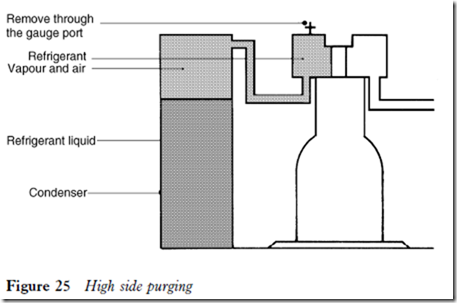High side purging
Like low side purging, the practice of purging from the high side is also unacceptable and must be discontinued. When it is certain that non-condensables are present in a system a leak test must be carried out on the entire system and the leak repaired. If a plant has been recently installed or it has been subject to service or repair it is possible that nitrogen could have been inadvertently left in the system. If air has entered the system in sufficient quantity the effect could possibly be of excessive operating head pressure similar to that of nitrogen left in the system. The removal of a non-condensable can be costly if the operating charge of refrigerant is large. The system would need to be completely discharged, evacuated and then re-charged.
A non-condensable gas will be lighter than refrigerant vapour and will rise to the top of a condenser/receiver when the plant is at rest. Removal of the non- condensable must take place at the highest point. Some condensers/receivers are fitted with a gauge connector or valve for this purpose. This connector may be in the form of a ‘purge screw’ on older type equipment. Removal of a non- condensable can easily be achieved via the gauge port on the high side of the compressor head. The system should be ‘pumped down’ and a short period of time allowed for the non-condensable to rise to the highest point. The procedure for removal is detailed in the section covering recovery/removal
of refrigerant. Figure 25 shows the location of the refrigerant and non- condensable (air) in the high side of a system and the gauge connection.
The removal of non-condensables therefore should be carried out by using a vacuum pump. Purging air from a system charged with refrigerant would also release some of the refrigerant to the atmosphere.
It is the duty of any service or installation engineer to protect the environment by discontinuing the release of CFCs and HCFCs to the atmosphere whenever servicing or installing refrigeration equipment.
In the case of nitrogen being present in a system, this can be purged from both the low and high side.
